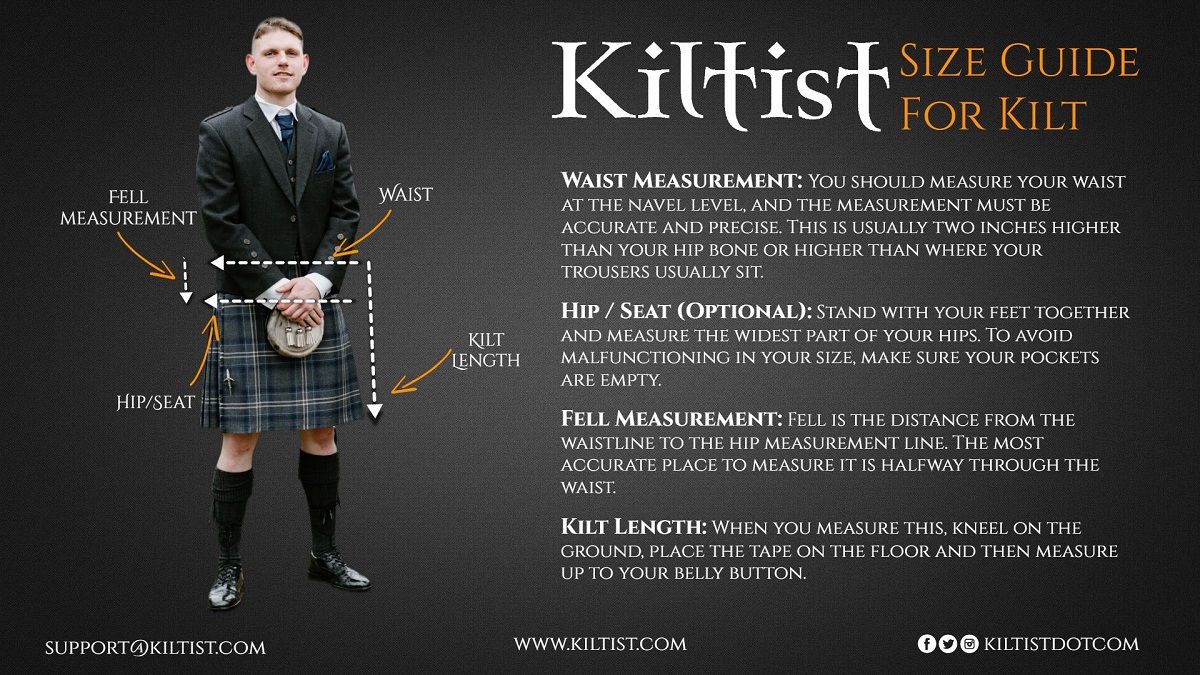Getting the right measurements for a kilt is crucial to ensure a perfect fit and proper wear. Kilts are not like regular trousers or skirts—they are tailored specifically to sit high on the waist and fall to the knees. This guide will walk you through the essential steps for measuring yourself or someone else for a kilt.
For a simpler guide: Please visit our Size Guide
What You Need for Measuring
Before you begin, gather the following:
- A flexible tape measure (preferably cloth or tailor’s tape).
- A notepad and pen to record measurements.
- A mirror or a helper for accuracy.
Key Measurements for a Kilt
There are three main measurements you need to take for a kilt:
- Waist Measurement
- Hip Measurement
- Kilt Length
Step-by-Step Guide to Measuring for a Kilt
1. Measure Your Waist
- Wrap the tape measure snugly around your natural waist.
- This is higher than where you would normally wear trousers—usually at the navel or just below the rib cage.
- Make sure the tape is level all the way around and not too tight.
- Record this measurement in inches or centimeters.
???? Tip: Breathe normally and avoid sucking in your stomach for the most accurate measurement.
2. Measure Your Hips
- Place the tape measure around the widest part of your hips.
- This is typically at the fullest part of your buttocks.
- Keep the tape measure parallel to the floor and snug, but not tight.
- Write down the number.
3. Measure the Length of the Kilt
- Stand upright with your feet shoulder-width apart.
- Place the tape measure at your natural waistline (where you took your waist measurement).
- Run the tape down to the middle of your kneecap.
- Record the length in inches or centimeters.
Tip: If you are measuring yourself, use a mirror or ask someone to help to ensure accuracy. Avoid leaning forward, as this can distort the measurement.


Common Mistakes to Avoid
- Measuring at the Wrong Waistline: Always measure at the natural waist, not where you wear jeans or trousers.
- Incorrect Posture: Stand upright without slouching or stretching unnaturally.
- Loose Tape Measure: Ensure the tape measure is snug against the body for precise measurements.
Special Considerations
- Kilts for Men vs. Women: While the measurements are similar, women might prefer a slightly shorter length depending on their personal style or event requirements.
- Custom Fit Kilts: If you're ordering a custom-made kilt, double-check your measurements and share them exactly as taken. Kilts are tailored based on these numbers and are difficult to alter afterward.
- Weight Fluctuations: If you anticipate changes in your waist size (e.g., weight loss or gain), account for an extra inch or two in the waist measurement.
Measuring for Accessories
- In addition to the kilt, you may need measurements for accessories such as:
- Kilt Hose (Socks): Measure the circumference of your calf where the top of the hose will sit.
- Belt and Buckle: Typically corresponds to your waist measurement but confirm with the kiltmaker.
- Sporran Chain: Measure around your waist at the height where the sporran will hang.
Why Accurate Measurements Matter
- A well-measured kilt fits snugly at the waist and allows free movement without slipping or feeling restrictive.
- Ill-fitting kilts can look awkward and may not sit correctly, which undermines the overall appearance.
Conclusion
Measuring for a kilt may seem daunting at first, but following these simple steps ensures a great fit and comfort. Whether it’s for a formal event, a traditional ceremony, or casual wear, a properly fitted kilt adds confidence and elegance to your appearance.
If you’re ready to order your kilt or need help choosing the right one, check out Kiltist.com for a wide range of kilts and accessories tailored to perfection.
FAQs
1. Can I measure myself for a kilt?
Yes, but having someone help ensures better accuracy, especially for the length measurement.
2. What if my measurements fall between sizes?
Opt for the larger size, as it’s easier to adjust a kilt that’s slightly loose than one that’s too tight.
3. Do I need to wear anything specific while measuring?
Measure over lightweight clothing or underwear for the most accurate results.
4. Can I wear a regular belt with my kilt?
Kilts require special belts with wider buckles, which are typically designed for traditional wear.
5. How do I ensure my kilt stays in place?
Proper measurements and secure fastening using the kilt buckles and belt will keep it comfortably in position.





